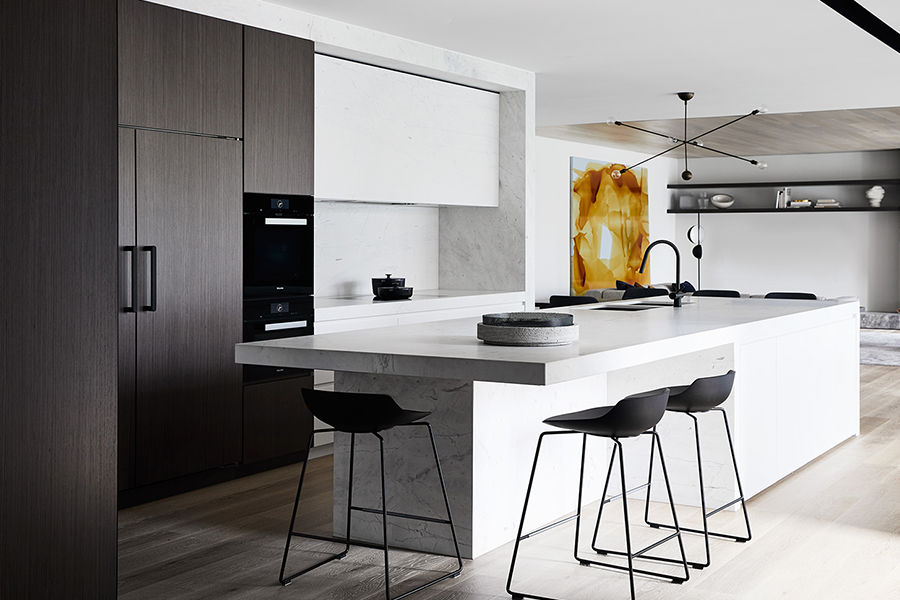Interior designers love what they do.
That usually means they want to try it all — from baroque to industrial to shabby chic.
Sound like you?
If so, it might be time to take your interior design business to the next level by finding your niche.
Specializing in a niche lets you become an expert in your field — and that leads to more clients and more money.
This article will help you choose an interior design niche and build your business around it.
What is an interior design niche?
An interior design niche is an area of specialty.
It’s the thing you’re known for and what you do best. It sets you apart from the competition.
Some designers naturally fall into a niche by following their interests or the needs of the market. Others have to consciously decide to focus on a certain niche.
If you’re not yet sure which niche to pursue, the tips in this article can help you pick the best one for your interior design business.
Examples of niches in interior design
Your niche can be a particular style, a type of client, a building type, a budget range, or a combination of multiple factors.
Here are a few examples of niches that a designer could have:
- Mid-century modern
- Art deco
- Open-concept corporate offices
- Family kitchens
- Upscale restaurants
- Low-cost home offices
- Biophilic design
- Interior redesign
- Staging homes for sale
Image Credit: Brand Minds
Read also – How To Start Your E-design Business?
What are the benefits of finding a niche?
You might wonder if you really need an interior design niche. Wouldn’t it be better to leave yourself open to any type of work?
Focusing on a niche has real benefits for your business. Let’s look at why.
1. Stand out from the crowd
There are 42,897 interior designers employed in the United States.
The chances are that at least a few of those designers are your local competition.
Finding a specialty puts you in a smaller market. You’re not just an interior designer, you’re the interior designer who specializes in Scandinavian-style room designs. There’s not as much competition for that title.
Image Credit: ArchDaily
Read also – Best Digital Marketing Strategies for Interior Designers
Having a niche also helps you connect with the people who want your services the most.
Someone looking for a new home office design might not know how to find the right designer. But when they turn to Google, searching “home office interior designer” could turn up your website.
2. Become an expert
You’ve probably heard the expression, “Jack of all trades, master of none.”
When you don’t have a niche, that’s you. You may be decent at many types of design, but you don’t have time to build your expertise in a single specialty.
When you focus on one niche, you become more knowledgeable and experienced with that sort of work. You can show clients an extensive portfolio that proves that you have more experience in your niche than the competition does.
You also get a better understanding of the market. You know who the typical clients are in your niche and what problems they need you to solve.
That helps you improve your marketing and outreach and land more jobs.
3. Have more fun
Don’t just choose any niche — choose one you love. That way, your whole career is based on doing your favorite type of design.
Having a niche lets you ignore the work that doesn’t interest you and concentrate on the projects you enjoy most.
4. Better promote yourself
Marketing a niche interior design service is easier than marketing general interior design.
For one thing, you know your audience well. You’re an expert on their needs. That means you can make a deeper connection with your target market by providing solutions to their most common problems.
Plus, your promotions will stand out more if they offer something different or more specialized than the other interior design marketing campaigns.
5. Raise your rates
You can make more money if you have a niche.
In any field, the experts tend to command higher fees than the generalists. When people want something done especially well, they turn to an expert.
When it comes to your niche, you’re the expert. Raise your rates accordingly.
Image Credit: Fit Small Business
Read also – 20 Instagram Marketing Tips For Interior Designers
How to find your niche as an interior designer: 6 tips
We’ve established that an interior design niche helps you grow your business and have more fun in the process.
But how do you choose one?
Establishing a specialty is a big decision. Your niche is the world you’ll be living in every day. Here are our top six tips for picking the right niche for you.
1. Follow your passion
The most important thing is to choose a niche you enjoy.
Most of your projects from now on will be in this niche. You’ll be talking to people about it when you network and focusing on it in your advertising.
You don’t want to end up feeling like the grass is greener in a different niche.
When you think about choosing a specialty you love, maybe something comes to mind immediately. If it doesn’t, try looking through your portfolio or making a list of all the types of projects you’ve done.
When you look over your past work, which designs excite you the most? What was the most fun to work on? What do you feel most proud of?
Those types of interior design are good candidates for your niche.
It’s also a good idea to think about the long-term. You like this type of design now, but will you stay interested in it for years? You’re less likely to get bored if your specialty allows for variety and creativity.
2. Evaluate your skills
Passion is great, but it’s also important to be honest with yourself about your abilities.
Where do you really shine? If you’re going to promote yourself as an expert in a certain niche, it should be an area you’re good at.
If you have a deep interest in a niche where your skills could use work, it’s not the end of the world.
Build up your knowledge and your portfolio. Find opportunities to take on projects in the new niche and research everything you can about it. There may be local or online courses you could take to improve your skills.
But don’t choose a niche until you’re confident that you can be excellent at it.
3. Imagine your ideal client
Interior design niches aren’t just about style. Each niche market comes with its own typical client. Think about who you would like to work with on a regular basis.
Would you rather do a project for a business or an individual?
Do you get excited about spending an extravagant budget, or would you rather create simple designs for families?
Whoever your typical client is, you’ll become very familiar with them. As a niche expert, you’ll get to know what their struggles are, what motivates them, and what elements of interior design they find important.
4. Look at past projects
Review your past interior design work. If you studied design in a certificate or degree program, you can go through your course projects, too.
Look for patterns.
Which projects did you enjoy the most? See if they have anything in common. It could be a style, a type of space, or a type of client.
Also, think about which projects made your clients the happiest. If companies looking for modern office designs always rave about your work, it’s probably something you’re great at. Plus, you already have connections in that world who could recommend you to similar clients.
Finally, consider what types of designs you get hired for most often. If you’re constantly getting asked to design tiny houses, you might be able to make a living doing just that.
5. Find gaps in the market
Your interests and skills matter, but so does the market.
The goal is to find a specialty you love that can also bring in revenue.
The best niche is one with high demand but low supply. In other words, plenty of clients in your area need this type of design, but not a lot of interior designers are doing it.
There are a few ways you can analyze your local market:
- Network with other interior designers, architects, and vendors — they might have insights you don’t.
- Look at any websites where you typically find interior design work — what specialties are in demand?
- Check out the websites of your competitors — see what niches exist in your area and how oversaturated they are.
- Research the demographics of your location — for example, an area full of wealthy young couples will have different needs than a community of middle-class retirees.
- Simply start looking for clients in your niche and see how it goes.
If you’re interested in e-design (which can be considered a niche of its own), your local market doesn’t matter as much.
6. Take your time
You know by now that there are many benefits to finding a niche. But you don’t have to commit to one right away.
This is especially true if you’re new to interior design. Try out all types of work before you decide what suits you best. You might find that you naturally fall into a niche as you build your business.
Many experienced interior designers are open to mentoring newcomers. You could find someone in your potential niche and learn from them. Local interior design schools or industry groups sometimes have lists of willing mentors.
If you already have experience but just can’t decide on a niche, take the time to experiment. Seek out projects that interest you and pay attention to what you might like to pursue as a specialty.
How to get started with your interior design niche
Congratulations, you picked a niche!
Now what?
Once you decide which interior design specialty to pursue, you have to get the word out to potential clients in that niche.
Here’s what to do.
Become a real expert
When you have a niche, people hire you thinking you’re an expert in that area.
Make sure it’s true.
Learn everything you can about your new area of expertise so that you can offer your clients value that they couldn’t get from a generalist interior designer.
Build a portfolio
A potential client should be able to look at your portfolio and immediately understand what your niche is.
High-quality photos of your designs are the best way to show off your expertise. You can also include the work you did along the way, like concept sketches and mood boards.
If you’ve already done a lot of projects in your field, that shouldn’t be hard to put together. But what if you’re just starting out?
One way to build an impressive portfolio, even if you don’t have a lot of real photos yet, is to include photorealistic 3D renderings of your designs. You can make the renders easily using interior design software.
This software lets you draw or upload a floor plan and drag-and-drop 3D models of furniture, decor, and accessories into it.
When your design is complete, you can take a “snapshot” of it. The picture looks like a real photo of your design. You can even create a virtual tour of the space you decorated.
Market your expertise
It’s time to let the world know about your niche. Make sure your marketing campaigns promote you as a specialist.
There are several ways to do that. Let’s take a look at four of them:
1. Write an interior design blog
Start a blog on your website (or on a platform like WordPress or Squarespace) talking about your interior design niche. Writing articles establishes you as a voice of authority on the subject.
The possibilities for what to write about are endless. A few easy topics include:
- Tips for design in your niche
- Your interior design process
- Behind the scenes designing in your niche
- Favorite furniture or accessories for your niche
2. Post on social media
Your social media presence should be focused on designs in your niche.
Whether you’re giving your existing Instagram page a new look or starting fresh, fill your social media with pictures of specialized designs.
3. Run ads
You can promote your business with paid advertising.
Google Ads is the biggest ad platform out there. Google lets you target users searching specific keywords on the search engine.
Run ads focused on keywords in your niche, like “retail interior design.”
Facebook Ads (and most other social media ad platforms) has good options for targeting your ads based on demographics and interests. Show your ads to the people most likely to be clients in your niche.
4. Ask for testimonials
These days, people often turn to online reviews before they decide on a product or service.
A few good reviews or testimonials in your niche will help you land future clients. If none of your current reviews are in your new area of specialization, reach out to previous clients in that niche and ask if they’ll leave a review.
If they loved your work, they’ll often be happy to write a review or a testimonial for your site.
Conclusion
Choosing a niche is one of the early steps for building your interior design brand. A niche will help you stand apart, reduce competition, and establish yourself as an expert in the field. Take the time to think about your interests and to understand the local market.
Each stage of the interior design process will be made easier and more efficient if you have the correct business tools. Foyr Neo is a powerful interior design platform designed specifically for you, the designer. With a set of powerful tools, you can go from idea to photo-realistic rendering in minutes, including:
- The option to select from thousands of pre-loaded objects such as furniture, plants, accessories, and more—or upload your own 3D models to produce the precise design your clients desire.
- On-demand production of 4K photo-realistic renderings.
- Advanced lighting and visualisation options are available.
- Capabilities to do real-time 3D editing.
We enable designers to spend less time with software and more time with their clients by merging the capabilities of various tools into one platform. Foyr Neo is now available for a 14-day free trial, allowing you to explore the potential of infinite creation.












